Creating a 10/22 Build Checklist is long overdue for me. Shooting is more fun than writing, but I realized there was a need for this article. Building a custom rifle from scratch? Or maybe you want to customize the one you got for Christmas? Either way, I’m going to list out all the parts you’ll need.
Before you start, have a plan
Building a rifle or Charger is simple enough, and requires no special tools. What it does require is a plan. Determining your use case before you start will save you money and headaches in the long run. Changing your plan as the build progresses is okay, but having a starting point helps. Do you want a plinker, precision rifle, light field rifle, a Charger, or a “tactical rimfire”? Those are just some “themes” I have seen. Give it some thought as you read through the available options below.
Breaking down your 10/22 Build Checklist, from receiver to sighting system
Covering every manufacturer out there is not possible. So keep in mind that there are more options than what I’ve listed. Focusing on the main components is more important than any single brand. As I created this article, I tried to stick to the well-known brands. In the future, I hope to create a listing of the smaller brands, as it’s important to support the little guys too.
Starting with the receiver, I’ll go through all the parts to complete the firearm, and then discuss sighting system options. Building a precision rifle and topping it with irons or even a reflex sight makes little sense. Likewise, a Charger or Steel Challenge-style rifle is rarely well-matched to a high-magnification scope. Planning your build so that it all works together is the ultimate goal. Here we go!
The foundation of every build is the receiver
Starting with an aftermarket receiver is the first item on my own personal 10/22 Build Checklist. This allows me to build a Charger or rifle, without running afoul of NFA rules. If you’re in the United States, and want a barrel under 16″ without added expense and paperwork, start with an aftermarket receiver. Breaking them down into two categories below, I’ve got the less expensive options listed first. These are generally best for Chargers and lighter rifles. Spending more on a higher-end receiver doesn’t guarantee better accuracy. But you will get a better finish inside and out.
Common lower-priced 10/22 receivers
- Sapoutfitters.com is a great source for OEM (Ruger) 10/22 and 22 Charger receivers. They’re all sourced from new, unfired Ruger firearms and available for fixed barrels as well as Takedowns. Ordering is easy, customer service is outstanding. Supporting a small business is the icing on the cake. Want more? Use code “industryoutsider” for a 5% discount.
- Brownells BRN-22 is another budget choice. I liked them better when they were under $100, but watch for sales and discounts. Bonus: they include the v-block and hardware.
High-end aftermarket 10/22 receivers
- Tactical Innovations offers the widest range of receivers. Looking to start with something other than black or silver? They have quite a few color options. Digging deeper, you’ll find railed and flat-topped receivers, left-hand charging, and takedown options too. Warning: They switched from anodizing to Cerakote for most of their colors, so they won’t match most other manufacturer’s colors.
- Summit Precision SP-22 receivers are a new product, backed by extensive experience. Looking ahead, Summit Precision will be offering complete rifles. In the meantime, I have two of their receivers, and they are beautiful. Exceptionally well made with a flawless finish, two of my precision rifles started with these.
- KIDD receivers at coolguyguns.com. Offering standard slip fit as well as their own Supergrade receivers, this is a popular choice for precision shooters. Personally, I would only use a KIDD receiver if I were planning a build with their optional rear tang, or their proprietary Supergrade barrel.
- Tactical Solutions is a bit of an outlier. Pricing looks a bit steep, until you realize that they include the bolt and charging handle. Inside, they have a dual guide rod system which is supposed to provide smoother cycling. I haven’t tried one, but welcome feedback from anyone who has.
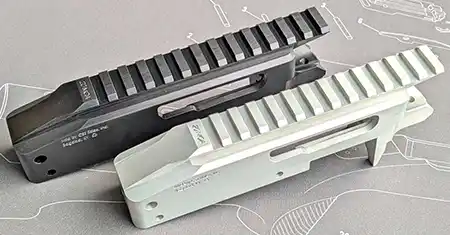
Choosing a rifle or Charger barrel
Breaking down barrels into rifle and Charger categories is a necessity for multiple reasons. First, there are just too many options. Second, no one wants to wade through the entire list if they are just looking for one or the other. Resisting the urge to further break down the list, I’m not separating barrels with irons from those without. Nor am I using a separate category for steel barrels vs sleeved/tensioned barrels. But I will explain the difference, for those that aren’t aware. Note also that the “bull” or “heavy” barrel is no longer exclusively 0.920″ in diameter. Some are smaller. It’s important to understand barrel diameter when it comes to choosing a stock or chassis as well.
Traditional barrels are steel, and generally include a taper (sometimes called a “pencil barrel”) or they may be larger diameter (usually called a “bull barrel”). Skinny is lighter, larger diameters are heavier and stiffer. Fluting is sometimes applied for weight savings and heat management. Combining the stiffness of a large diameter barrel with the weight savings of a skinny barrel, we have the sleeved and tensioned barrels. Starting with a smaller diameter barrel, an outer tube of aluminum or carbon fiber is added. This results in lower weight than a similar-sized steel barrel, but improved stiffness over a similar-weight steel barrel. They look cooler too.
If your 10/22 Build Checklist happens to start with a takedown receiver, look for the * denoting that this company has takedown-compatible barrels. Also note that they are listed in no particular order. And I left out some niche and specialty brands, at least for now.
Charger-length barrels
- *Volquartsen Charger barrels. Wrapping everything in carbon fiber is the Volquartsen way. All their Charger barrels have it. Takedown barrels include a detachable cantilever rail for consistent zero. If you’re on a tight budget, maybe don’t click their link.
- *Summit Precision barrels. Offering eight lengths from six to 14 inches, and 15 colors, Summit Precision is the custom builder’s dream. They have also supplied barrels to some of our favorite brands, like Fletcher Rifle Works and Enoch Industries.
- *Acculite barrels. Another builder’s favorite, Acculite (formerly WhistlePigGunBarrelCo, AKA Whistle Pig) has a variety of fixed and takedown barrels with or without flutes and threading. I consider this the value brand, and by that, I don’t mean cheap. Putting one on your 10/22 Build Checklist will get you more than your money’s worth.
- *Tactical Solutions barrels. I’m applying the law of diminishing returns here. These are good barrels, but the price makes them a hard sell for me when it comes to a Charger.
- KIDD barrels. I’ll admit to buying one, and even to wanting another. But unless you want to build a benchrest Charger, their steel barrels are too heavy for most builds. You can get one with a lightweight fluted aluminum sleeve too.
- Beyer Barrels. Okay, their website needs an update, but the barrels are excellent. And when you call, Clint Beyer usually answers. They’ll do custom work if you need special fluting, colors, etc.
- FJ Feddersen barrels. I’ve never used them, but they are usually well-regarded, and priced affordably.
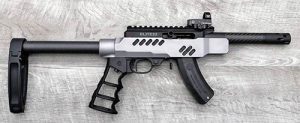
Rifle-length barrels
- *Summit Precision Barrels. Like their Charger offerings, the Summit Precision barrels are offered in multiple lengths (16.1″, 18.5″, and 20″) and over a dozen colors. Additional options include either the stainless finish at each end, or a matte black FNC finish. These are excellent barrels, striking a balance between weight and performance. They look great too.
- *Volquartsen Barrels. Looking for stainless, carbon-sleeved, or a takedown barrel with a cantilever mount? Volquartsen has you covered. They’re also the only brand I can recall with a carbon sleeve and irons.
- Acculite barrels. Owning the lightweight bull barrel category, Acculite is hard to beat. You get a lot of barrel for the money. Available with or without flutes and threading, they have a few color options too. Threaded, no flutes is the suppressor owner’s best friend.
- KIDD barrels. Going out on a limb, I’m going to share one truth, and one unpopular opinion. If your 10/22 Build Checklist includes the words “Match rifle”, you probably want a KIDD match barrel. They’re the default for most shooters wanting to throw together a precision 10/22 and come with Tony’s MOA guarantee. At the opposite end, I’d skip their lightweight and ultra lightweight barrels. Nothing wrong with them, I just don’t think they’re worth the asking price when similar performance is available elsewhere for less.
- Green Mountain barrels. Looking for a steel barrel that shoots great, but you’re on a budget? This is the brand for you. Heavy, tapered, threaded, fluted, stainless, blued or iron sight-equipped, they have them all.
- *Tactical Solutions barrels. They’ve got color options, threading, and flutes. But the real winner is their X-Ring takedown barrels equipped with Williams fiber optic sights. Forget about zero issues and the extra weight of scopes or reflex sights. Go light and fast.
- Beyer Barrels. Again, the website is pretty dated. The good news is that you can pretty much just call and tell them what you want, and they’ll make it.
- FJ Feddersen barrels. Another good option for steel barrels. Plenty of different contours and iron sight options.
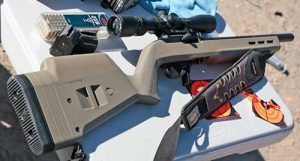
Stock or chassis? Aluminum, wood, or polymer?
Now that you’ve added the barrel to your 10/22 Build Checklist, you can choose your stock or chassis. This step comes after the barrel selection, as the barrel diameter may determine or limit your choices. Stocks are usually wood or polymer. Chassis options include polymer or aluminum. For our categorization here, stocks are traditional (mostly) shapes in wood or polymer. Listings under the chassis categories will be limited to those machined from aluminum. That’s an oversimplification, but we’re not here to split hairs.
10/22 stock options
- *Magpul 10/22 stocks are offered in a handful of colors for fixed and takedown rifles. Their Backpacker is the default choice for takedowns. If you’re on a budget, the new(ish) Magpul MOE X-22 stock is an excellent choice. Light, ergonomic, and it will accommodate tapered and heavy barrels. I expect to see many will have this on their 10/22 Build Checklist in 2025.
- *Boyds Hardwood Gunstocks is known mostly for its laminated wood stocks. Combining 37 thin layers of colored wood under immense heat and pressure, they’re as attractive as they are durable. Available in a variety of shapes and colors, you’ll find some sweet customization options like checkering and laser engraving. And each one is made to order.
- KRG Bravo rimfire stocks straddle the line between a stock and chassis (my review of the KRG Bravo refers to it as a chassis). Building one out with their extensive options list allows you to get a very custom and ergonomic fit from these polymer stocks.
- The Victor Company Titan is a similar polymer stock, with a much smaller accessory list. But it’s all business.
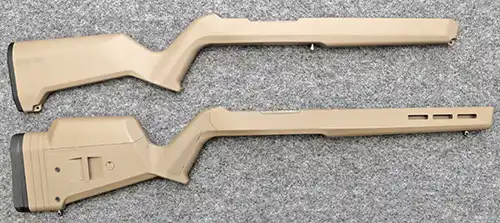
10//22 chassis options
- *PMACA was my first 10/22 chassis, and they are probably the least expensive option in an aluminum chassis. Utilizing AR grips and stocks, they have takedown models as well.
- *Midwest Industries offers cool chassis options for fixed barrel and takedowns. They’re a good choice if AR grips and stocks are more important than saving weight.
- Enoch Industries is the go-to for suppressor lovers. Combining light weight, pleasing aesthetics, and a wide barrel channel, they’re a great fit if you want a short barrel and fat suppressor.
- MDT offers their Oryx rifle chassis for the 10/22 action. Making great shooting products in Canada, I really like this company. They have great videos available to help hone your skills. I just can’t seem to find a chassis of theirs that I like.
- *Crazy Ivan offers what many consider the best all-around chassis. Sadly, the owner passed away a few years ago. Highly prized if you can find one, his family has tried to keep the business going. If this is on your 10/22 Build Checklist, you may want to select an alternate as well.
- Woox breaks all the rules. Mixing beautiful hardwoods with machined aluminum, they offer stocks and chassis systems. Definitely not for the budget builders, but nice to look at.
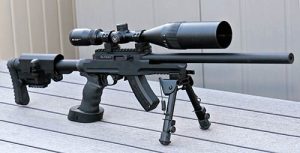
Triggers
When the Ruger 10/22 first came out, the trigger was designed for mass production. not precision. In other words, a heavy, somewhat gritty trigger. Other than a switch from aluminum to polymer housings, not much has really changed. Regardless of opinions stated elsewhere, the newer polymer versions are better. They have tighter tolerances and are generally better overall. Do not pay extra for a used aluminum housing unless you have a specific need for one. Ruger did release a BX trigger, which is an OEM unit with slightly improved internals. They are not consistent, trigger to trigger, so it pays to test one before you buy. They even package them so you can test it.
When choosing the trigger to add to your 10/22 Build Checklist, consider your application. A BX may be fine for plinking or hunting. Shooting fast, such as Steel Challenge, or doing some precision work generally requires a lighter trigger. Luckily, there are two major options. Upgrading the internals of an OEM housing is pretty economical, with good results. Replacing the entire trigger group with an aftermarket unit is another option. Splitting the difference, at least one company modifies OEM trigger units and then sells them. Something to keep in mind is that not all aftermarket housings are compatible with every stock or chassis.
10/22 OEM trigger upgrade options
- TandemKross Ultimate Trigger Kit is one of my favorites. Sporting a wide, flat trigger, it’s great for speed, and light enough for light target duty.
- Velocity Triggers offers both curved and flat triggers, in a wide variety of colors. I love their flat triggers, and they match Summit Precision barrels very well.
- KIDD offers their “Trigger job” kit at less than 1/2 the cost of their single stage, and 1/3 the cost of their two stage triggers. Highly regarded.
- Volquartsen sells their target sear and target hammer separately or as part of their HP Action Kit.
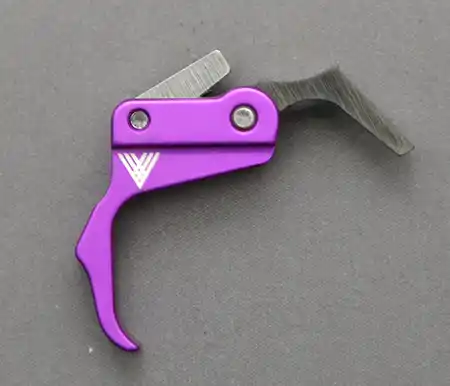
10/22 complete trigger options
- TandemKross Manticore and Manticore Lite triggers are designed from the ground up as completely new units. Here’s my review of the TandemKross Manticore trigger.
- KIDD single and two-stage triggers are the premium trigger for when you love shooting, and maybe hate money. The two stage goes down to a mere six ounces (3 for each stage). Put this on your 10/22 Build Checklist if you plan on competing in any sort of precision shooting discipline.
- Volquartsen TG2000 triggers are available in four colors. Pull weight is fixed at 2.25 lbs, but they are adjustable for pre and over-travel.
- Hornet triggers are not exactly a household name (despite being in business since 2001, but they have some great options and their prices are easy on the wallet.
- Timney also offers a wide range of options for the 10/22. Their Calvin Elite is the most ergonomic trigger I have tried.
- Pike Arms (Tactical Innovations) has both housings and complete triggers in colors to match their receivers.
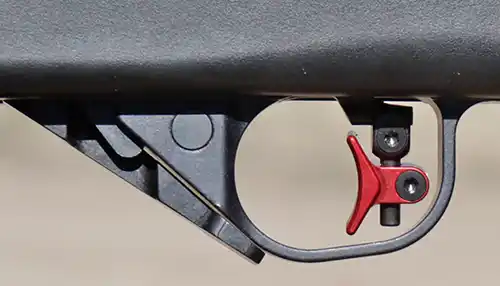
Bolts
Keeping the price of their rifles down is important to Ruger. This is why the OEM bolt is cast instead of CNC machined. It saves time and money, and they go bang nearly every time. Comparing a cast bolt to an aftermarket CNC bolt, there are many differences. Starting with the headspace, this critical fit between bolt and barrel is one of the keys to consistent ignition and accuracy. Next is the cross pin over the firing pin. Without it, the firing pin can bounce around a bit, causing inconsistent ignition. Finally, the bottom rear edge is radiused and polished. This allows the bolt to travel over the hammer smoothly, with less resistance.
While they’re making aftermarket bolts look better, the internal components are better too. That firing pin is generally harder, for longer wear. Reshaping the tip is done to improve ignition. Extractors are harder as well, and the edge is usually sharper, sometimes cut at 89 instead of 90 degrees, for more aggressive extraction. Millions of rifles still have their factory bolts. Buying an aftermarket unit will offer more reliable and consistent ignition and extraction. So be sure to budget for one in your 10/22 Build Checklist.
- KIDD 10/22 bolts
- Brownells 10/22 bolt. *Does not have the pin over the firing pin. Not a dealbreaker, but I only recommend this one if you are already placing an order with them.
- TandemKross KrossFire bolt for the 10/22.
- Volquartsen sells a Competition 10/22 bolt with all the goodies. For dedicated suppressor use with low-velocity ammo, check out the Volquartsen Firefly 2.0 bolt.
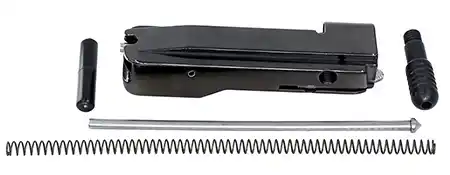
Charging handles
As we near the end of our 10/22 Build Checklist, we come to one of the most overlooked parts. Charging handles are made up of a guide rod, a spring and a handle. Do not get a cheap one from the online auction place, or the “rainforest” website. Machining a true (straight) rod is critical for smooth operation. And the spring has to have the correct amount of resistance. If you try to save a few bucks, you will probably end up with some cycling issues. So I’ll make this easy, and list the ones I have used without any issues. Oh, the OEM unit is fine too, most of the time. Until it isn’t.
- TandemKross Spartan Skeletonized charging handle. Available in red, black or silver. Smooth and reliable.
- KIDD 10/22 charging handles. Pricing is premium, but so is the quality. Comes with different springs so you can fine-tune it to your ammo selection.
- Tactical Innovations 10/22 charging handles. Choosing a color is probably the most difficult part here. Plenty of options.
Those parts you almost forgot about
Rounding out your 10/22 Build Checklist are a handful of parts that sometimes get overlooked. Holding the trigger group to the receiver are the trigger pins. I recommend TandemKross KrossPins as they are easy to get in and out, yet won’t fall out. Above and behind them is the bolt stop pin, which is usually replaced with a non-steel option. Polymer is quieter, which improves the suppressed shooting experience. With the exception of the Brownells receiver, most don’t include a v-block and screws. These are necessary for attaching the barrel to the receiver.
Confusing matters, the action screw which attaches the receiver to a stock or chassis is also referred to as a “takedown screw”. Building a takedown requires two, you’ll only need one for fixed barrel builds. Some stocks and chassis models include them in proprietary lengths, others don’t include them at all. Checking before ordering your stock or chassis will save you some grief.
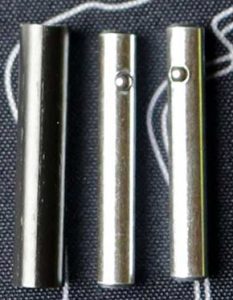
Sighting options
After completing the required parts of your 10/22 Build Checklist, it’s time to figure out sighting options. Listing brands would be too difficult, so I’m only offering the types for now. Iron sights are basic, usually inexpensive, and are included with some barrels. Well, most “irons” are now fiber optics when it comes to the 10/22. If your barrel doesn’t include them, adding them later can be pricey. Your stock or chassis should have a low cheek rest to accommodate them too.
Red (or green) dots are compact (usually) electric sights that are generally used where target acquisition speed is more important than precision. Selecting the right one for your application usually comes down to physical size, color, reticle type/size, and magnification. Rounding out the sighting systems are scopes. LPVO (Low Power Variable Optics) are gaining popularity for shorter ranges, and come in 1-4x to 1-8x. Traditional compact rimfire scope ranges are 2-7x, 3-9x, and 4-12x, but 6-24x and 5-25x are not uncommon for longer range or precision shooting.
Additional links:
Common Ruger 10/22 upgrades – basic upgrades for new rifles and Chargers, and I think they are still under $20.
If you have questions or suggestions, feel free to comment below, or email me directly. I’ve created this as a resource, so user feedback is always appreciated.
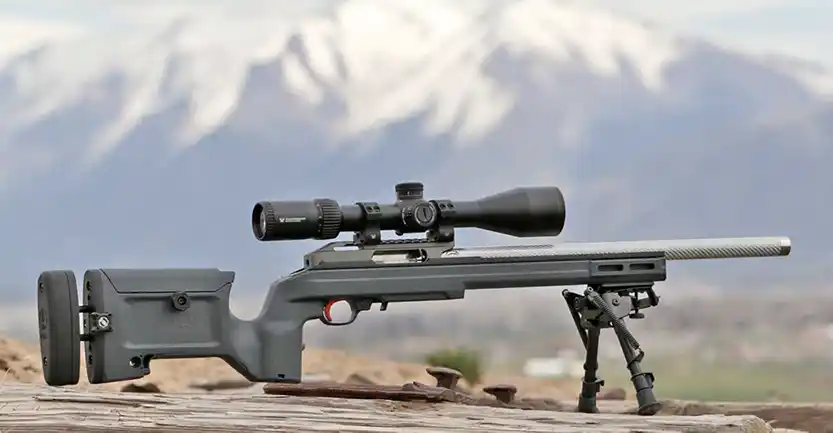
Barrels: Shilen, their match barrels are extremely good, also Proof Research and TacSol
Bolts: JWH Custom bolts are high quality as well
Triggers: TacSol XRT, PikeArms Billet Trigger Assembly
My logic was that if you were doing a build with a Shilen, Proof Research, or Lilja barrel, you probably didn’t need a checklist, you know what you need. I have two JWH Custom bolts, but didn’t mention them because I wasn’t sure if they’ve improved their customer service since Covid. Completely forgot about the XRT (I think everyone did). Pike Arms triggers were just added. Thank you! Going forward, I plan on doing separate articles for each component. So if you are looking for a trigger, it will be one long list of trigger options. Or barrels, etc.